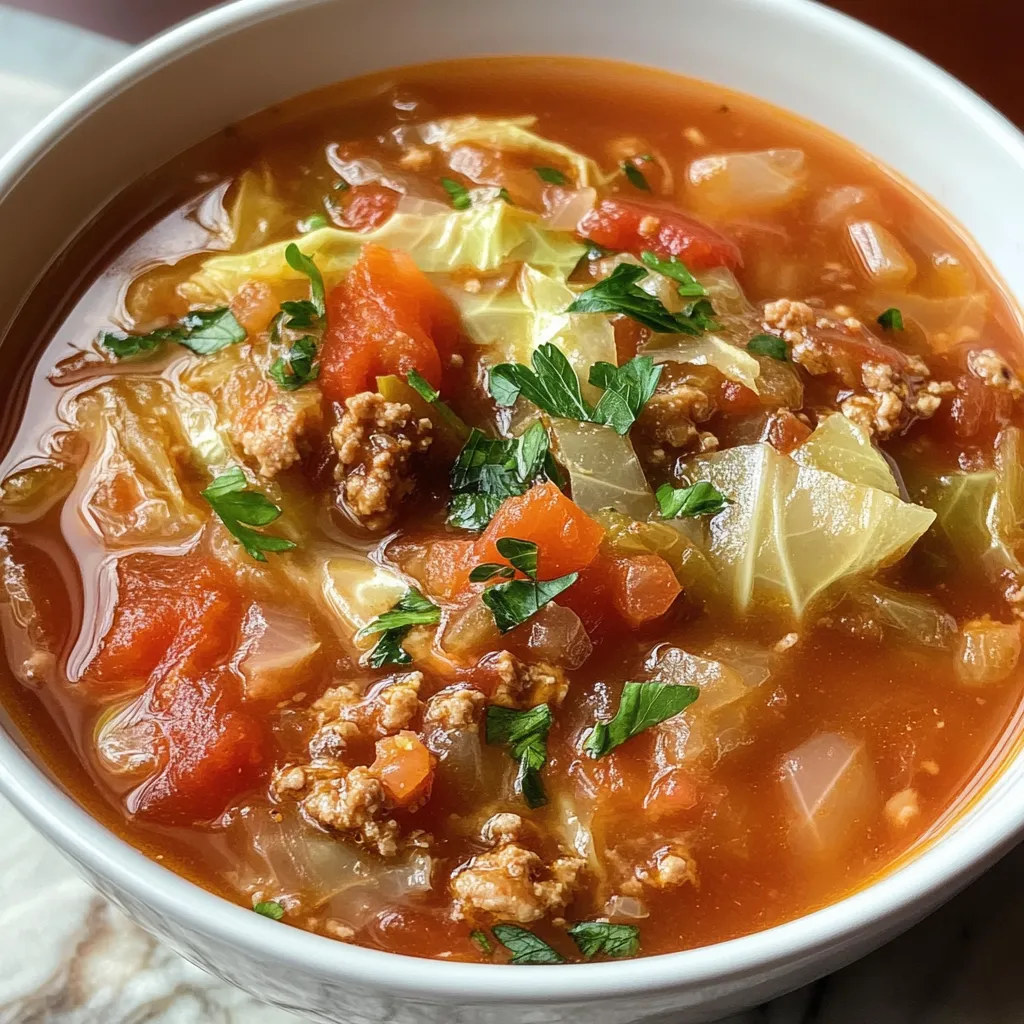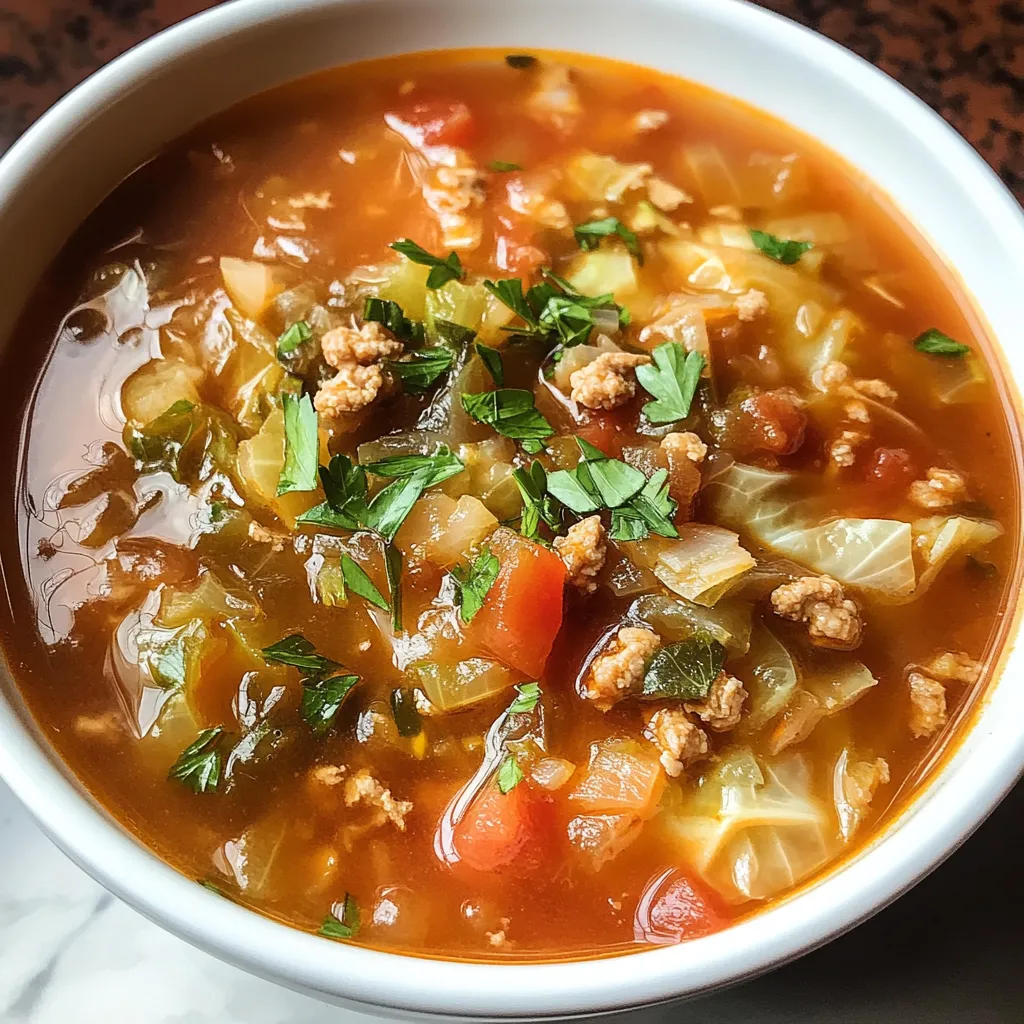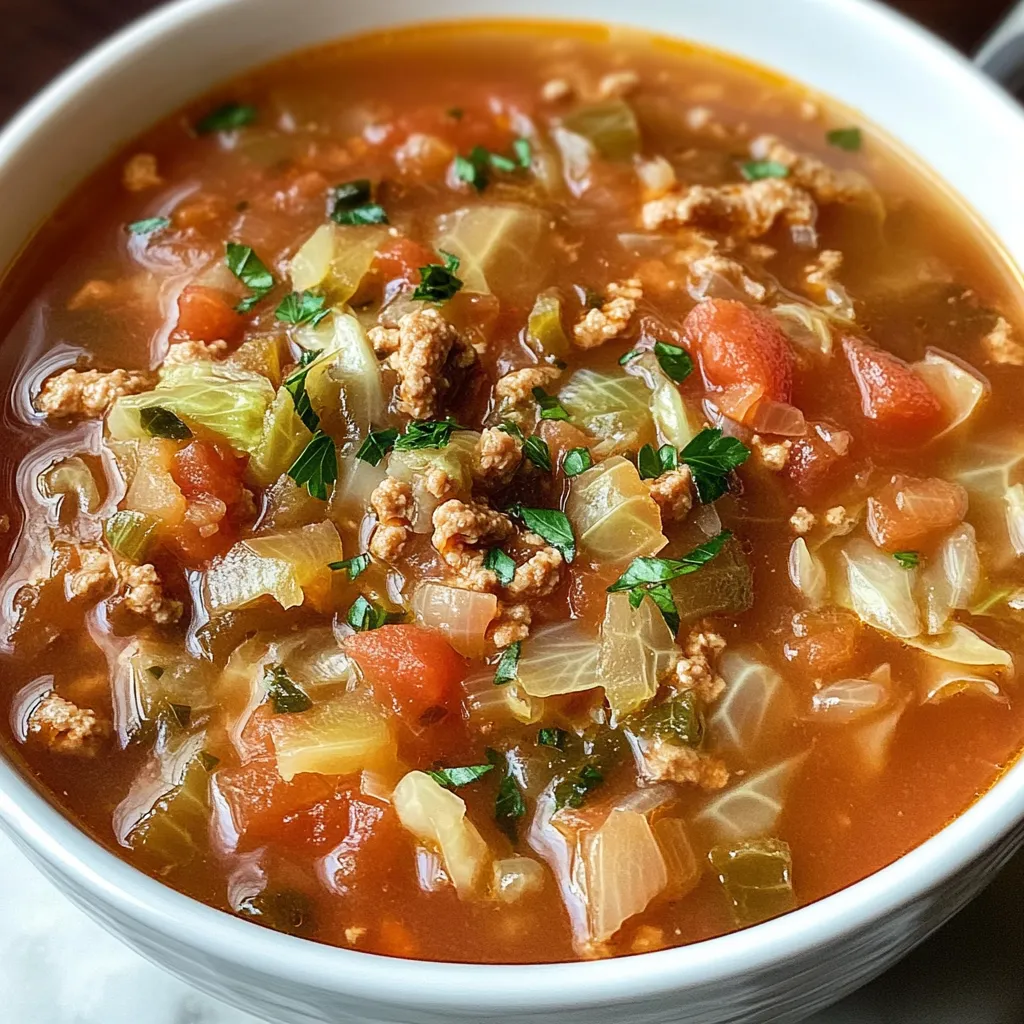 Save
Save
This cabbage roll soup turns classic Eastern European tastes into a bowl of pure comfort that'll warm you up with every taste. The mix of ground beef, soft cabbage, and fluffy rice swimming in tomato broth packs all the good stuff from traditional cabbage rolls without the hassle of stuffing and rolling. This easy one-pot meal fills your home with amazing smells while making dinner prep a breeze, so it's just what you need on busy nights when you want homemade goodness without standing at the stove forever.
I came up with this soup during a freezing cold January when I was craving my grandma's cabbage rolls but couldn't spare the time to make them properly. The smell that filled my kitchen instantly took me back to those family Sunday meals growing up. My family actually liked this broken-down version better, loving how each spoonful had the perfect mix of meat, veggies, and soup without fighting with those tricky cabbage leaves.
Key Ingredients
- Ground Beef: This makes up the meaty base of our hearty soup. Go for 85/15 ground beef for just the right amount of flavor and texture without too much fat.
- Green Cabbage: Adds a sweet, tender element that soaks up all the surrounding tastes. Look for firm, heavy cabbage heads with tight leaves for the freshest flavor and best bite.
- Long-grain Rice: Gives you lovely little pockets of starchy goodness throughout. Cook it separately first so it won't get mushy by drinking up too much broth.
- Tomatoes: Bring a bright tanginess and natural sweetness. Regular canned diced tomatoes work great, but fire-roasted ones add a hint of smokiness.
- Tomato Paste: Makes the tomato flavor stronger and thickens the broth. Just a spoonful really changes the depth and richness of the whole soup.
- Beef Broth: Adds a savory backbone to the entire dish. Homemade is amazing, but good-quality store-bought works wonderfully too.
- Onions and Garlic: Create the flavor foundation that's crucial for authentic taste. Regular yellow onions work best as they soften nicely while the soup simmers.
- Herbs and Spices: Boost flavor without taking over. Dried herbs are perfect here as they wake up in the hot broth and release all their goodness.
Making Your Soup
- Getting Started:
- Warm up olive oil in a sturdy Dutch oven or big soup pot over medium heat until it shimmers. Toss in ground beef, breaking it into small bits with your spoon. Sprinkle with salt and pepper while cooking until it's nicely browned, about 5-7 minutes. Taking time to brown it well creates deeper, richer flavors.
- Building Flavor:
- Throw in diced onions with the browned meat and cook until they're see-through and slightly golden, around 4 minutes. Add minced garlic and cook just until you can smell it, about 30 seconds, but don't let it brown or it'll taste bitter. These aromatics create the essential taste foundation that runs through the whole soup.
- Tomato Magic:
- Mix in tomato paste and cook for 1-2 minutes, letting it darken slightly against the hot pot. This step transforms regular tomato paste into something much more complex and flavorful. Add diced tomatoes with their juice, stirring while scraping any stuck bits from the bottom of the pot.
- Adding Seasonings:
- Sprinkle in dried herbs (basil, thyme) and smoked paprika, mixing to coat everything. Warming the dried herbs in the fat helps release their flavors and makes them taste stronger in the finished soup. The smoked paprika adds a nice depth without overpowering the traditional taste.
- Pouring in Liquids:
- Add beef broth and water, stirring well to mix everything together. Bring it all to a gentle bubble before turning down to a simmer. Getting the temperature right matters—boiling too hard can make the meat tough and the broth cloudy.
- Adding Cabbage:
- Toss in the chopped cabbage, stirring to get it all under the broth. Cover and keep at a gentle simmer for 25-30 minutes until the cabbage is as tender as you like. Adding cabbage at this point (not earlier) keeps it from getting too soft or developing strong cabbage smells.
- Mixing in Rice:
- Stir in already-cooked rice during the last 10 minutes, just long enough to heat it through without it falling apart. Using cooked rice instead of raw means it'll have the perfect texture without soaking up too much of your broth.
- Final Touch:
- Taste your soup and adjust the seasonings, adding more salt, pepper, or a little brown sugar if needed to balance flavors. The touch of brown sugar helps smooth out tomato acidity without making the soup taste sweet. Let the soup sit, covered, for 5-10 minutes off the heat before serving so all the flavors can get to know each other.
 Save
Save
My grandma always told me to be patient when making soup, saying "you can't rush good flavor." While creating this recipe, I found out she was right—letting the soup simmer slowly instead of cranking up the heat pulled amazing flavor from simple ingredients. Now I always make double batches, knowing the leftovers will give us even tastier meals throughout the week.
Ways To Serve
This filling soup makes a complete meal by itself but gets even better with thoughtful sides. Try it with a chunk of crusty bread or warm rolls for soaking up the tasty broth. Drop a spoonful of sour cream on top for a creamy richness that goes perfectly with the tomato tang. For a true Eastern European touch, serve some pickled veggies on the side to contrast with the soup's savory warmth. Small rye bread sandwiches with good butter make traditional companions that round out the meal nicely.
Tasty Variations
Switch up this flexible recipe by changing ingredients for different flavor profiles. Try ground turkey or chicken for a lighter version with its own unique taste. Make it vegetarian by using chopped mushrooms and lentils instead of beef, with veggie broth as the base. Try different grains like barley or farro for new textures and nutrition. Toss in extra veggies such as carrots, celery, or bell peppers for more color and nutrients. Play around with herb combinations like dill and caraway to get a more authentic Eastern European flavor.
Keeping It Fresh
Keep your soup tasting great by storing it properly. Let it cool completely before putting it in shallow, airtight containers in the fridge for food safety. Refrigerated soup lasts up to 4 days, and the flavors actually get better during storage. When heating it up again, warm it gently over medium-low heat, adding a splash of broth if needed to get back the original consistency. For longer storage, freeze portions in freezer-safe containers for up to 3 months. Thaw in the fridge overnight before reheating for the best texture.
This cabbage roll soup honors the beautiful simplicity of Eastern European cooking while making it fit our busy modern lives. The way basic ingredients come together through careful cooking creates something much greater than their parts. Whether you're making it for a weeknight family dinner or serving it to guests with crusty bread and good butter, this soup delivers the kind of satisfaction that turns first-time tasters into lifelong fans. The fact that it gets better with time makes it perfect for cold winter days when comfort food isn't just nice—it's necessary for feeding both body and soul.
 Save
Save
Recipe FAQs
- → Can I make this soup in a crockpot?
- Sure! Start by browning the beef, onion, and garlic. Then, put everything in the crockpot. Cook on low for 6-8 hours or on high for 3-4 hours. Stir in cooked rice during the last half-hour.
- → Should I cook the rice beforehand?
- Yes, cooked rice is best. Tossing uncooked rice straight into the soup will soak up too much broth and might get mushy. Cooking it separately keeps it just right.
- → Can I swap out ground beef for turkey?
- You can! Ground turkey, chicken, or meat alternatives all work. Just remember that turkey is leaner, so adding a little more oil when cooking helps.
- → What’s the best way to store leftovers?
- Cool down the soup and move it to a sealed container. It keeps in the fridge for about 3 days, tasting even better the next day! You can also freeze it for up to 3 months.
- → Can I throw in extra vegetables?
- Definitely! Toss in carrots, celery, bell peppers, or zucchini. For firmer veggies like carrots, cook them early. Softer ones like zucchini can go in during the last 10 minutes.
